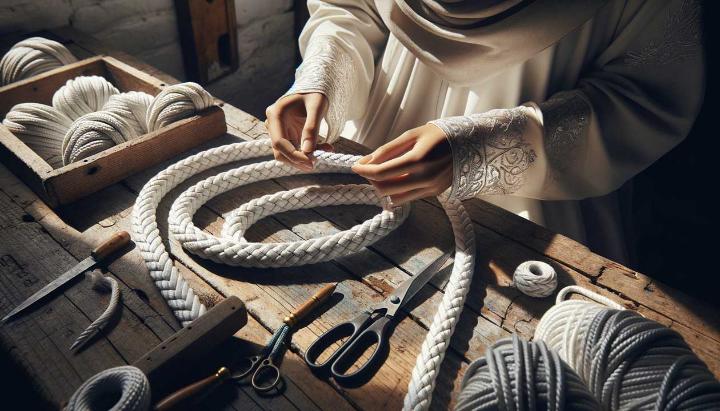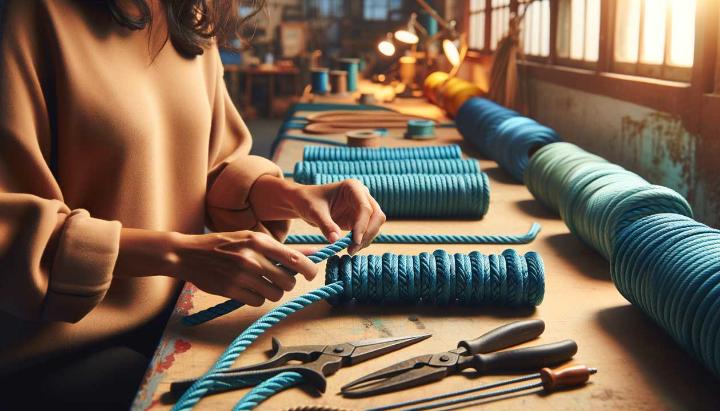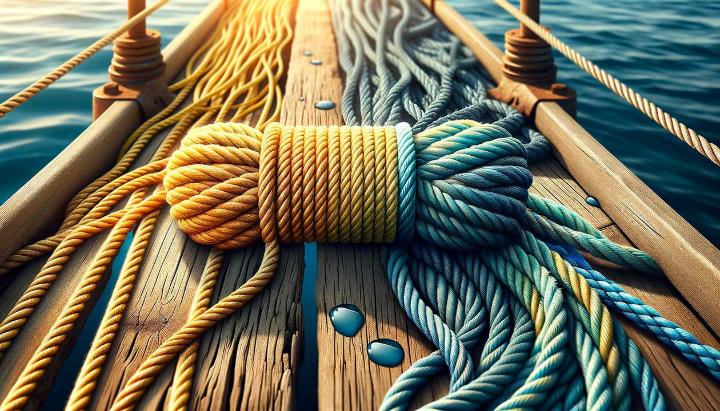Have you ever wondered why some ropes float while others sink? Or why certain ropes feel smooth in your hands while others have a bit more grip? The world of hollow braided ropes is a fascinating one, filled with materials that each bring their own unique strengths to the table. Today, we're diving into the realm of hollow braided polypropylene rope variants, a topic that's more exciting than you might think!
As a leading rope manufacturer, iRopes has seen firsthand how the right choice of rope can make or break a project. Whether you're rigging a sailboat, setting up a rescue line, or looking for the perfect rope for your industrial needs, understanding the nuances of hollow braided ropes is crucial.
In this post, we'll explore the intricacies of hollow braided polypropylene ropes, compare them with their polyester (Dacron) counterparts, and uncover the unique features that make each shine in different applications. From the lightweight and buoyant nature of polypropylene to the durability and low stretch of Dacron, we'll guide you through the maze of options to help you make an informed decision for your specific needs.
So, whether you're a seasoned professional or just rope-curious, buckle up! We're about to embark on a journey that will change the way you think about these essential tools. By the end of this read, you'll be equipped with the knowledge to choose the perfect hollow braided rope for any situation. Let's get started!
Materials Used in Hollow Braided Ropes
When it comes to hollow braided ropes, the choice of material can make all the difference in performance and durability. As an avid sailor, I've had my fair share of experiences with various rope types, and I'm excited to share some insights with you.
Natural Fibers for Hollow Braided Ropes
Traditionally, natural fibers like cotton, hemp, and sisal were the go-to materials for rope-making. These materials have a certain charm and still find use in specific applications today. However, they do have their limitations, especially when it comes to strength and resistance to the elements.
Synthetic Materials in Modern Hollow Braided Ropes
In recent years, synthetic materials have revolutionised the rope industry. Let's take a closer look at two popular choices: polypropylene and polyester (Dacron).
Polypropylene: The Floating Wonder
A lightweight and buoyant synthetic material perfect for water-based applications.
Polypropylene has become a popular choice for hollow braided ropes, especially in marine environments. Its ability to float on water makes it ideal for water rescue operations and boating activities. Plus, it's resistant to moisture, chemicals, and UV rays, giving it an edge in durability.
On the flip side, polypropylene can be a bit slippery when wet and may degrade faster under intense sunlight compared to some other synthetics. It's all about choosing the right tool for the job!
Polyester (Dacron): The Durable Workhorse
Polyester, often referred to by the brand name Dacron, is another synthetic material that's gained popularity in hollow braided ropes. It's known for its excellent strength-to-weight ratio, low stretch, and superior abrasion resistance.
- Durability: Polyester ropes can withstand harsh conditions and heavy use, making them suitable for various industrial and marine applications.
- Low stretch: This property ensures that the rope maintains its length under load, which is crucial for many tasks.
- UV resistance: Polyester holds up well against sunlight, maintaining its strength over time.
While polyester ropes may be slightly more expensive than polypropylene, their longevity often makes them a cost-effective choice in the long run.
As we dive deeper into the world of hollow braided ropes, we'll explore more about the specific characteristics and applications of these materials. Whether you're rigging a sailboat or setting up a rescue line, understanding the pros and cons of each material will help you make the best choice for your needs.
Did you know? Hollow braided ropes typically have 8, 12, or 16 strands, offering a balance of strength and flexibility.
Hollow Braided Polypropylene Rope: Characteristics and Uses
As a seasoned sailor and rope enthusiast, I've had my fair share of experiences with various types of ropes. Today, I'm excited to dive into the world of hollow braided polypropylene rope, a true marvel in marine and water-based applications.
Key Features of Hollow Braid Polypropylene Rope
Hollow braid polypropylene rope is a synthetic wonder that's been making waves in the marine industry. Its unique construction typically features 8, 12, or 16 strands, offering a perfect balance of strength and flexibility. Let me break down some of its standout characteristics:
- Lightweight and buoyant: This rope floats like a charm, making it ideal for water-based activities and rescue operations.
- Impressive strength-to-weight ratio: Don't let its light weight fool you – this rope can handle substantial loads with ease.
- Resistance to the elements: It laughs in the face of moisture, chemicals, and harsh UV rays, maintaining its integrity even in challenging environments.
- Easy spliceability: Working with this rope is a breeze, allowing for quick and secure connections when needed.

Applications and Benefits in Marine Environments
In my years of sailing, I've seen hollow braid polypropylene rope used in countless applications. Here are some of the most common:
- Dock lines: Its floating nature makes it perfect for securing boats to docks without the risk of sinking and tangling around propellers.
- Water sports: From water skiing to wakeboarding, this rope's buoyancy and strength make it a favourite among enthusiasts.
- Safety lines: In rescue situations, having a floating rope can be a literal lifesaver.
- General marine use: From rigging to mooring, its versatility shines through in various nautical applications.
What sets hollow braid polypropylene rope apart in these settings? Its ability to perform consistently in wet conditions is unmatched. Unlike natural fibre ropes that can rot or mildew, this synthetic marvel stays strong and reliable, even after prolonged exposure to water.
Have you ever tried using a heavy, waterlogged rope? It's no picnic, let me tell you! That's where the lightweight nature of hollow braid polypropylene really shows its worth. It's easy to handle, even when wet, making it a joy to work with in marine environments.
Pro tip: When choosing a hollow braid polypropylene rope, look for UV-stabilised versions for maximum longevity in outdoor use. Your future self will thank you!
As we navigate through the world of ropes, it's clear that hollow braid polypropylene has carved out a special niche in marine applications. Its unique blend of strength, buoyancy, and durability makes it a top choice for water enthusiasts and professionals alike. Whether you're securing your boat or gearing up for some water sports, this versatile rope is ready to rise to the occasion – quite literally!
Unique Features of Dacron Hollow Braided Ropes
As we venture further into the world of hollow braided ropes, it's time to shine a spotlight on Dacron, a material that's been turning heads in the marine and industrial sectors. Having worked with various rope types throughout my career, I can confidently say that Dacron hollow braided ropes bring something special to the table.
Construction and Strength of Dacron Hollow Braid
Dacron, a high-quality polyester fibre, forms the backbone of these remarkable ropes. The hollow braid construction, typically featuring 8, 12, or 16 strands, creates a rope that's both strong and flexible. Imagine a rope that feels sturdy in your hands yet bends effortlessly around cleats and bollards - that's the magic of Dacron hollow braid for you.
What sets this construction apart is its coreless design. Unlike solid braided ropes, hollow braids have no central core, which might sound counterintuitive at first. But trust me, this seemingly simple change opens up a world of possibilities, especially when it comes to splicing and customisation.

Applications and Advantages of Dacron Hollow Braided Ropes
Now, you might be wondering, "What makes Dacron hollow braided ropes stand out in a sea of options?" Let me break it down for you:
- Durability that defies the elements: These ropes laugh in the face of UV rays, mildew, and rot. I've seen Dacron ropes withstand years of harsh marine conditions, looking almost as good as new.
- Strength that doesn't compromise flexibility: Whether you're hauling heavy loads or need precise control, Dacron hollow braids offer an impressive strength-to-weight ratio while remaining easy to handle.
- Low stretch performance: Unlike some materials that feel like elastic bands under load, Dacron maintains its length admirably. This characteristic is crucial for applications where consistent tension is key.
- Splicing made simple: The hollow construction makes splicing a breeze. I remember the first time I spliced a Dacron hollow braid - it was like the rope was designed for it!
From my experience, Dacron hollow braided ropes excel in various applications. They're a favourite among sailors for halyards and sheets, thanks to their low stretch and durability. In industrial settings, I've seen them used for everything from lifting operations to crowd control barriers.
Pro tip: When selecting a Dacron hollow braided rope, consider the number of strands. More strands generally mean a smoother, more flexible rope, but may come at a higher price point.
Have you ever found yourself in a situation where your rope choice made all the difference? Whether you're a seasoned professional or a weekend enthusiast, understanding the unique features of Dacron hollow braided ropes can elevate your rope game. Next time you're in the market for a versatile, durable rope, give Dacron hollow braid a try - you might just find your new go-to option!
Comparing Dacron and Polypropylene Hollow Braided Ropes
As a seasoned sailor and rope enthusiast, I've had the pleasure of working with various types of hollow braided ropes over the years. Today, we'll dive into the fascinating world of Dacron and polypropylene hollow braided ropes, two popular choices that have revolutionised the marine industry. Understanding the unique properties of these materials is crucial for making informed decisions about which rope best suits your specific needs.
Properties and Characteristics of Dacron and Polypropylene Ropes
When it comes to hollow braided ropes, Dacron (polyester) and polypropylene each bring their own set of strengths to the table. Let's break down their key characteristics:
- Strength: Dacron generally offers superior strength, especially in wet conditions. I've noticed that Dacron ropes maintain their integrity even after prolonged exposure to water, making them ideal for long-term marine use.
- Weight: Polypropylene takes the crown here. Its lightweight nature makes it incredibly easy to handle, which I've found particularly useful during long sailing trips where every gram counts.
- Flexibility: Both materials offer good flexibility, but polypropylene edges out slightly, allowing for easier knot tying and manipulation.
- Buoyancy: If you need a rope that floats, polypropylene is your go-to choice. I can't count the number of times a floating polypropylene line has saved the day during water rescues or retrieval operations.
- UV Resistance: Dacron outperforms polypropylene in this aspect. I've seen Dacron ropes withstand years of sun exposure with minimal degradation, while polypropylene tends to break down faster under intense sunlight.

Applications and Use Cases for Hollow Braided Ropes
Having used both Dacron and polypropylene ropes extensively, I can attest to their unique strengths in different scenarios:
Dacron Hollow Braided Ropes Excel In:
- Halyards and sheets: The low stretch and high strength of Dacron make it perfect for sail control lines.
- Anchor lines: Its durability and resistance to chafe are invaluable when your boat's safety is on the line.
- Mooring lines: The ability to maintain strength when wet is crucial for long-term docking.
To master these specific applications, check out our guide to mastering yachting with double braid polyester rope, which complements Dacron's strengths perfectly.
Polypropylene Hollow Braided Ropes Shine In:
- Water rescue operations: The buoyancy of polypropylene is a literal lifesaver in emergency situations.
- Temporary dock lines: Easy handling and floating properties make it ideal for quick tie-ups.
- Waterskiing and wakeboarding: The rope's ability to float keeps it out of the propeller and visible on the water's surface.
Safety Tip: Always inspect your ropes regularly for signs of wear or damage, regardless of the material. A compromised rope can lead to dangerous situations on the water.
When choosing between Dacron and polypropylene hollow braided ropes, consider the specific demands of your application. Are you prioritising strength and durability for long-term use? Dacron might be your best bet. Need a lightweight, floating line for water-based activities? Polypropylene could be the perfect fit.
Remember, the beauty of hollow braided construction lies in its versatility. Both materials offer excellent splicing capabilities, allowing you to customise your ropes for specific needs. I've personally created custom mooring lines with spliced eyes using Dacron hollow braid, achieving a professional-grade result that rivals factory-made options.
For more information on durable braided ropes, be sure to read our post on discovering the best dock lines, which can enhance your understanding of these rope materials' performance.
As you weigh your options, don't hesitate to reach out to experienced sailors or marine supply professionals for advice tailored to your unique situation. After all, choosing the right rope is not just about performance – it's about safety and peace of mind out on the water.
Understanding the different materials used in hollow braided ropes is crucial for selecting the right option for specific applications, whether it's the lightweight, floatable nature of hollow braided polypropylene rope or the durability of polyester (Dacron). Polypropylene ropes offer high strength-to-weight ratios and resistance to moisture, making them ideal for water sports and rescue operations. Dacron ropes, known for their longevity and UV resistance, are perfect for marine and industrial uses. Comparing these options highlights the strengths, durability, and cost differences, helping you make an informed choice between hollow braid polypropylene rope and Dacron ropes based on your needs.
Get in Touch for Customised Rope Solutions
If you have specific requirements for hollow braided polypropylene rope or need expert advice on choosing the right material for your application, please fill in the form above. Our rope specialists at iRopes are ready to assist you with tailored solutions that meet your needs.